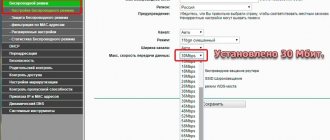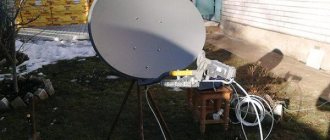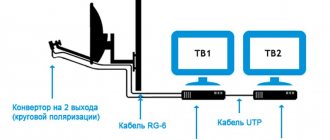In this article, we will figure out together how satellite Internet works and what satellite Internet is.
With the beginning of a new era and a round of progress in the field of telecommunications, satellite communications appeared. Soon it began to provide an Internet connection.
| The principle of operation of satellite Internet is that the satellite receives and transmits user requests through the provider. |
This means that the satellite receives a signal, transmits it to the provider and, having received certain data, transmits information through the satellite.
What is satellite internet
Let’s imagine that you are in a settlement remote from a big city or in a place that is difficult to reach for Internet towers, where there are none at all (taiga, ocean). The problem with the distribution of stable Internet communications has always been there, but with the advent of satellite communications everything has become much simpler.
Satellite Internet in short is a method of transmitting an Internet connection through artificial geostationary satellites, which act as a repeater for transmitting and receiving signals.
The development of satellite communications began in the 60s of the last century. The Intelsat organization was assembled, to which many countries of the world joined, except the USSR.
The first ones released a satellite 4 years after its formation, and at about the same time, the USSR launched the Molniya-1 satellite into orbit.
At first such attempts were not successful. Even 30 years later, with the advent of the Internet, access to the global network was not available. But with the passage of time, the development and reduction in cost of technology, we can now use satellite Internet.
Access options
Currently, there are only two options for providing access to satellite communications. They are different, each of them requires special equipment.
Review and configuration of the D-Link Dir-320 modem
Regardless of the access option, satellite Internet remains one of the least common methods of transmitting and receiving data. Basically, it is used only by subscribers who require complete independence from various operators.
Important! This method of information exchange is as autonomous as possible; the only thing that affects the quality of communication is weather conditions.
There are currently two different ways to receive and transmit data using satellite communications:
- Unilateral. In this particular case, reception is carried out using a satellite, and transmission is carried out through conventional terrestrial communications.
- Double-sided. Here, both the reception and transmission of information takes place using a satellite.
The domestic satellite communications market already boasts 2 million subscribers. In addition, statistics show that not all of them are located in remote parts of the country. Most are located in the suburbs of large settlements, where summer cottages are traditionally located. The most common is a one-way access method, which outperforms two-way access due to a more affordable price.
How does satellite internet work?
Satellite transmission can be carried out in two ways: symmetric and asymmetric . Let's figure out what it is.
Symmetrical satellite internet
Symmetrical satellite Internet lk-tricolor.ru
The first thing you need to understand is how they differ. Unlike one-way (asymmetric) satellite Internet , where data is transmitted through a satellite channel and sent through a terrestrial network, symmetric (two-way) does not require such a complicated operating algorithm, and data is transmitted and received via satellite in both directions.
This provides protection from terrestrial interference during data transmission, as well as higher signal speed and clarity. But in order to use such a service, more expensive equipment is required that will ensure data transmission to the satellite.
VSAT equipment is a ground antenna with a diameter of approximately 1.5 meters with a terminal and a transceiver.
Such equipment must be installed strictly by a professional, since installing a satellite dish requires certain technical knowledge. The setup is carried out by your operator, and you will only be required to enter the minimum final settings.
The antenna fully justifies itself, as it can provide stable Internet during bad weather conditions, transfer of large volumes of information and multiple access.
Asymmetric satellite internet
Asymmetric satellite Internet lk-tricolor.ru
The difference from symmetrical is that when transmitting a signal from a user to a satellite, the signal first goes to the provider, who sends response data via the satellite and the user receives the Internet. This is a cheap and easy to install way to use satellite Internet, but its disadvantages are as follows:
- Dependence on terrestrial data transmission. If any problems arise with the operator, weather or terrain conditions do not allow the signal to be transmitted quickly, then the Internet speed will decrease significantly.
- Difficulty connecting other devices to the network (smartphone, laptop, tablet). The joint operation of several devices will also slow down the Internet.
- Many operators have already abandoned one-way Internet, so that in the future it will be even more difficult to connect and find an operator who does not prefer two-way connection in the next few years.
Satellite, provider and Internet
There are two types of satellite Internet - synchronous and asynchronous. The first means that you don’t need anything else besides satellite equipment, and the second means that you also need an additional Internet connection. Let's figure out what this means, how it works and what are the differences between these schemes.
The main thing in each type of connection is a satellite that flies around the Earth and transmits data. If the angular speed of the satellite is equal to the speed of rotation of the Earth, then the satellite seems to hang motionless at one point in the sky and constantly sends radio waves to a certain area.
But the Internet satellite itself does not know anything. The Internet is not recorded in it. You can imagine that a satellite is a mirror from which the Internet provider’s signal is reflected. This means that somewhere on earth there is an Internet provider that, using powerful antennas, sends radio signals to this satellite.
Is it possible to turn off the Internet?
To make communication more reliable and satellite coverage greater, the provider launches several satellites, each of which is designed for its own reception area.
Satellite Internet: types of connection
As we have already found out, the connection is divided into 2 types: one-way and two-way .
One-way satellite communication is a system of relationships between the satellite antenna, converter, board and the network connection itself. This is the simplest and cheapest type, which does not require any additional costs for connection.
The operation of one-way data transmission is based on an asymmetric type of satellite Internet.
This is not only the easiest way to transfer data, but also the most inefficient. It is not suitable if you need to do a lot of work on the Internet, for example, send and receive data from other users.
Since this principle of asymmetric communication involves terrestrial transmitters, deterioration in their operation will lead to a decrease in the quality of the connection in general.
Two-way transmission is carried out using a symmetrical connection type.
To connect it, you will need some special equipment, since data transmission occurs directly between the user device and the satellite dish.
You will need:
- Satellite antenna.
- LNB converter.
- Transmitter.
- Satellite terminal.
This is a more expensive option for Internet communication, but its advantages are that many users can connect to the Internet and at the same time it will still “pull” complex programs.
All installation is done by a professional, and setup is handled by your operator. You only need to take small steps to complete the setup.
Main events of the Starlink project
January 2015
- Opening of an office in Redmond, Washington, created specifically for the development of the Starlink project.
November 15, 2021
- filing an application with the FCC for the use of the frequency spectrum of the Ku and Ka bands by a satellite constellation of 4425 spacecraft.
March 1, 2021
- submission of an application for the use of the V-band frequency spectrum by a satellite constellation of 7518 spacecraft.
March 30, 2021
- Receives FCC clearance for November 2021 application for a network of 4,425 satellites.
February 22, 2021
– The Falcon 9 launch vehicle successfully launched two test satellites (Microsat-2a and Microsat-2b) as a secondary payload.
Subsequently they were renamed Tintin-A and Tintin-B. October 2021
- reorganization of the Redmond office with the dismissal of seven employees, including two top managers of the Starlink project.
Among those fired were Vice President of Satellite Business Rajeev Badyal and one of the chief designers Mark Krebs, who was involved in the satellite Internet project while still at Google. Elon Musk replaced them, setting the new leaders the task of starting satellite launches in mid-2019. November 8, 2021
- filing an application with the FCC to change the application for the Ku and Ka band network (4425 satellites), with the allocation of the first stage of 1600 satellites and a reduction in their orbital altitude from 1100 km to 550 km.
November 15, 2021
- Received FCC approval for a March 1, 2021 application, network of 7,518 V-band satellites.
December 20, 2021
- The Air Force Strategic Planning and Experimentation Office has awarded SpaceX a $28 million contract to test various ways the military can use the Starlink satellite network service over the next three years.
February 1, 2021
- Space X submitted an application to the FCC to enable and operate 1 million subscriber terminals.
April 8, 2021
– SpaceX's application for a license to operate a private Earth remote sensing system is approved.
Thus, SpaceX gets the right to photograph both its own satellites and the Earth. Permission was issued for low-resolution color imaging for 60 spacecraft in a circular orbit with an inclination of 53°. April 26, 2021
- The FCC approved SpaceX's application to modify its previously announced Ku-band network.
Now we are talking about 1584 satellites at an altitude of 550 (instead of 1150) km and with an inclination of 53°. May 2021
- videos from the Starlink train begin to appear on the Internet - numerous satellites of this group looked like a moving train in the night sky.
The delighted exclamations of the spectators begin to be accompanied by the indignation of the astronomers. The epic “SpaceX vs astronomical community” begins. May 23, 2021
- launch of 60 Starlink satellites in version v0.9 (Earth-to-space feeder line in Ku-band).
The first public photos of satellites and their placement under the fairing of the Falcon 9 rocket.
June
28, 2021 — SpaceX has filed a notice with the FCC to begin testing ground terminals. We are talking about about 200 terminals with a flat phased array and ten with a parabolic antenna. August 30, 2021
- SpaceX submits another application to the FCC to change the characteristics of the constellation: now the first stage of the Starlink network should consist of 72 orbital planes, not 24. The number of satellites in each plane will change accordingly: instead of 66 there will be only 22.
October 7, 2021
- SpaceX asked the FCC to submit 20 applications to the ITU for 30 thousand satellites in low orbit.
November 11, 2021
- launch of 60 Starlink version 1.0 spacecraft.
The altitude of the circular orbit for separating the satellites from the rocket is 280 km, that is, significantly lower than in the first launch. 20 November 2021
- The ITU's World Radiocommunication Conference (WRC) has decided on the time that operators of low-orbit satellite constellations have to fully deploy their systems.
From the moment the ITU receives an application (submitted by the national administration of the country in which the constellation operator is located) for the allocation of frequency spectrum for the operator’s satellite network, a countdown of 7 years begins. No later than 7 years later (otherwise the application is cancelled), the operator is obliged to begin deploying its satellite network in such a way that 10% of spacecraft are launched in the first 2 years, 50% - within the first five years, and the entire constellation (100% of the declared satellites) ) after 7 years. If the operator fails to do this, its spectrum rights are limited in proportion to the number of satellites launched at the end of those seven years. January 7, 2021
- third launch of 60 Starlink spacecraft (second launch of version 1.0 satellites).
January 29, 2021
- fourth launch of 60 Starlink spacecraft (third launch of version 1.0 satellites).
February 4, 2021
- The Australian telecommunications regulator (The Australian Communications and Media Authority) has opened access for SpaceX to obtain a license with the right to provide services in Australia.
February 17, 2021
- fifth launch of 60 Starlink spacecraft (fourth launch of version 1.0 satellites).
March 18, 2021
- sixth launch of 60 Starlink spacecraft (fifth launch of version 1.0 satellites).
,
2021 — SpaceX is submitting an application to the FCC to change the architecture of the Starlink Ku/Ka-band network. All satellites will operate in an orbit between 540 and 570 km. April 22, 2021
- the seventh launch of 60 Starlink spacecraft (sixth launch of version 1.0 satellites).
April 23, 2021
- Elon Musk announces on Twitter that closed beta tests for Starlink services will begin in approximately 3 months, and public beta tests in approximately 6 months.
May 17, 2021
- the first photos of the subscriber terminal for the Starlink network appeared, the photo was taken at the gateway in the city of Merrilan (Wisconsin).
,
2021 — SpaceX has applied for a Basic International Telecommunications Services (BITS) license, which gives the right to provide telecommunications services in Canada. June 1, 2021
- SpaceX filed an application with the FCC for the 2nd generation of the Starlink network consisting of 30 thousand satellites in orbits from 328 to 614 km.
June 4, 2021
- the eighth launch of 60 Starlink spacecraft (the seventh launch of version 1.0 satellites).
One of the satellites has a VisorSat visor to reduce its visibility. June 13, 2021
- ninth launch of 58 Starlink spacecraft (eighth launch of version 1.0 satellites).
Additionally, three SkySat satellites were launched. June 14, 2021
- registration opens on the website www.starlink.com for those wishing to participate in beta testing.
June 21, 2021
- information about a Wi-Fi router for the Starlink terminal has appeared.
The router has received FCC certification and will be manufactured in Taiwan. August 1, 2021
- the first test results of the Starlink service appeared on the Internet: speeds up to 60 Mbit/s, latency from 31 ms.
,
2021 — SpaceX asked the FCC to expand the previously requested permission for 1 million user terminals to 5 million, justifying this by the fact that there was enormous interest in its system and the company received 700 thousand applications for testing.
,
2021 — tenth launch of 57 Starlink spacecraft (ninth launch of version 1.0 satellites). Additionally, 2 BlackSky satellites were launched. August 18, 2021
- eleventh launch of 58 Starlink spacecraft (tenth launch of version 1.0 satellites).
Additionally, 3 SkySat satellites were launched. September 3, 2021
- twelfth launch of 60 Starlink spacecraft (eleventh launch of version 1.0 satellites).
September 3, 2021
- SpaceX announces successful tests of a laser communication link between two Starlink satellites.
October 6, 2021
- thirteenth launch of 60 Starlink spacecraft (twelfth launch of version 1.0 satellites).
October 15, 2021
- Canadian telecom regulator CRTC approved the issuance of a BITS license to Space X for the right to provide basic communication services in Canada
October 18, 2021
- fourteenth launch of 60 Starlink spacecraft (thirteenth launch of version 1.0 satellites).
,
2021 – fifteenth launch of 60 Starlink spacecraft (fourteenth launch of version 1.0 satellites).
,
2021 — Space X begins a public beta testing program under the slogan 'Better Than Nothing'. Beta test participants are offered to purchase terminals for $499 (plus state tax and shipping costs) and a subscription fee of $99 per month with unlimited traffic volume. Speeds are promised in the range of 50-150 Mbit, but interruptions in communication are possible. In 2021, a significant improvement in the quality of service is promised due to software updates and an increase in the number of satellites.
,
2021 — Space X receives approval from ISED (Innovation, Science and Economic Development Canada) to use frequencies, and accordingly legal operation in Canada on November 14, 2021
.
— SpaceX has begun sending terminals for public beta testing to subscribers in Canada living south of the 50th parallel. UPD 02/07/21 November 25, 2021
– sixteenth launch of 60 Starlink spacecraft (fifteenth launch of version 1.0 satellites).
December 2, 2021
- SpaceX received permission to use the frequency resource in Argentina for the Starlink service
December 18, 2021
- SpaceX received permission to use the frequency resource in Germany for the Starlink service
Second half of December 2021
- SpaceX began sending out terminals for public beta testing for UK subscribers living south of the 50th parallel.
January 10, 2021
- Space X has received approval to use its service in the UK, Germany, Greece and Australia (https://www.bloomberg.com/news/articles/2021-01-10/elon-musk-s -starlink-broadband-terminals-gets-approval-in-uk
January 20, 2021
– seventeenth launch of 60 Starlink spacecraft (sixteenth launch of version 1.0 satellites)
January 24, 2021
– first launch of 10 Starlink version 1.0 spacecraft to the polar
January 24, 2021
- An image of the InterSatellite Link equipment on the Transporter 1 satellites is published, with information that they will become standard equipment on all satellites in 2022.
, 2021
- A document submitted by Space X to the FCC reports that the size of the StarLink network reached 10,000 terminals
February 4, 2021
– the eighteenth launch of 60 Starlink spacecraft (seventeenth launch of version 1.0 satellites).
Satellite Internet: subscriber identification
Subscriber identification
All information and data transmitted between the satellite and the subscriber is transmitted through your personal channel, that is, for a specific address. Such addresses are called MAC addresses .
All information transmitted from the satellite is marked with MAC addresses, but your receiver will only pick up the information that is intended for you, ignoring other ciphers.
A MAC address is a code, a device number of 48 unique characters, assigned to a network card of equipment in production. It cannot be repeated, receive signals for other numbers, and is assigned to absolutely every piece of network equipment when the IP address is your individual network connection number.
The recipient-sender side of the Internet already determines the IP address. It is needed so that the operator can compare the satellite equipment number (MAC) and its IP address in order to establish a connection between the Internet and traffic.
When working with a symmetric satellite connection at the subscriber's place, the operator compares these addresses centrally, automatically, without the participation of the subscriber. With an asymmetric connection, everything is much more complicated, since the operator does not have access to the subscriber’s personal MAC address. In order to get out of this situation, subscriber identification is carried out.
The subscriber informs the operator of his MAC number and is obliged to contact him when changing the IP address. And also cannot create one account, for example, for several devices. But in this case, the operator uses your hardware address, but it is possible to assign a virtual one to the user.
It is assigned from a special address space and calculated from the IP address. Everything works the same as with hardware. Filtering signals by this MAC address to receive data intended by the satellite proceeds as in normal mode.
Starlink network architecture
The figure shows the architecture of the Starlink network and its most important components, namely: The Space segment
is satellites in low orbit (the first 1,600 satellites are currently deployed in an orbit at an altitude of 550 km with an inclination of 53 degrees);
Ground segment
:
- Network Management System,
- Gateway stations,
- User Terminal
.
Rice.
The structure of the Starlink global satellite network As for the ground network, it is essentially built on the Google network. SpaceX itself has two autonomous networks registered - AS14593 and AS27277 (the latter is possibly used for SpaceX’s internal IT network). Judging by the available data, SpaceX subscriber traffic will be routed via leased fiber optic lines (mainly Google's own network, where possible) to the nearest nodes/traffic exchange points in the USA: LAX (Los Angelos), SEA (Seattle), ORD (Orlando), LGA (New York), SJC (San Jose), DFW (Dallas), IAD (Washington). In his tweet dated October 2, 2020, Elon Musk said that the company will try to place gateways directly on the buildings where the “servers” are located, apparently meaning Internet traffic exchange centers. As of November 2, 2020, SpaceX has IP addresses of Australia, New Zealand, Canada, Great Britain, Germany and Spain registered in AS (an autonomous system, in fact, the provider identifier under which IP addresses are registered). AS36492 is used by Google under the name "GOOGLEWIFI" to run public Wi-Fi hotspots, but is also used by Starlink for its IP addresses). There are two bands for Australia and New Zealand:
IPv4 103.152.126.0/24 Starlink Sydney PoP 1 user addresses (New Zealand) 103.152.127.0/24 Starlink Sydney PoP 2 user addresses IPv6 2406:2d40:1000::/36 Starlink Sydney PoP 2 user addresses 2406:2d40::/36 Starlink Sydney PoP 1 user addresses (New Zealand)
Canada:
143.131.2.0/24 SpaceX Canada Corp.
143.131.3.0/24 SpaceX Canada Corp. 143.131.4.0/24 SpaceX Canada Corp. 143.131.5.0/24 SpaceX Canada Corp. 143.131.6.0/24 SpaceX Canada Corp. 143.131.7.0/24 SpaceX Canada Corp. For Europe:
162.43.192.0/24 SpaceX Services, Inc. (ES, Madrid) 162.43.193.0/24 SpaceX Services, Inc. (ES, Madrid) 176.116.124.0/24 SpaceX Services, Inc. (UK, London) 176.116.125.0/24 SpaceX Services, Inc. (UK, London) 188.95.144.0/24 SpaceX Services, Inc. (DE, Frankfurt) 188.95.145.0/24 SpaceX Services, Inc. (DE, Frankfurt)
In the following material we will describe the functionality of each network element.
Equipment for satellite Internet
In order to use satellite Internet services, you need the necessary equipment at home. First of all, this is an antenna, a modem (receiver), a bracket (for mounting equipment), a media converter (a device that converts one signal medium into another, most often between receiving the signal and transmitting it to the device) and cable. All this is necessary for normal and stable signal reception. Neither element will perform its functions without the other.
Antenna
Antenna for satellite Internet lk-tricolor.ru
The antenna comes with a suitable transceiver and is connected to the receiver with a coaxial cable. The transceiver is quite heavy equipment weighing several kilograms. The “dish” itself is almost no different in appearance from the television one.
The transceiver is needed in order to provide a two-way type of communication (symmetrical). If you decide to establish an asymmetrical connection, this may create small problems in the form of more bulky equipment and a weaker signal.
Converter
Converter lk-tricolor.ru
It is used to receive and convert high frequency signals from a satellite in a symmetrical connection. Having converted the signal to lower frequencies, the converter transmits them through the cable. The fact is that in a free environment the electromagnetic signal is well distributed, but in a denser environment it is lost and a signal converter is used to prevent this.
Receiver, dvb card
Receiver for satellite Internet lk-tricolor.ru
Both devices have approximately the same final purpose - receiving a signal and transmitting it to other devices. Actually, in the receiver, namely, on the front panel, there is a connector for a DVB-S/DVB-S2 card.
Details
To start you need...
What is needed for one-way Internet
To connect one-way satellite Internet yourself, you will need a satellite Internet kit. Most often it consists of:
- PCI/USB DVB-S/S2 card, which is characterized by a high-speed stream transmission from the satellite. The card decodes the signal and sends it to your computer.
- A satellite dish, which is selected depending on the satellite broadcasting the signal and the provider.
- A converter that receives the signal and is located in the focus of the satellite dish. It sends the received stream to the DVB card. Ku-band converters with linear polarization are often used. Less commonly, an element with circular polarization.
- A coaxial cable that connects the converter and the DVB card, for which connectors with an F connector are used.
- A modem or telephone that is used as an outgoing channel in one-way technology.
After purchasing a set of equipment, all that remains is to install it correctly.
REFERENCE! The device that transmits the outgoing stream must be purchased separately.
What is needed for two-way Internet
To connect two-way satellite Internet, additional terrestrial sources are not needed, since data is received and transmitted only via satellite channels. With proper installation of two-way satellite Internet, it will work stably in all weather conditions. To install it, you will need:
- A Ku-band satellite antenna that receives and transmits signals.
- Blocks that transmit the BUC signal and the receiving LNB stream, which are installed on the satellite dish feed. They are standard for any type of antenna and are not tied to the satellite terminal.
- A terminal that is responsible for receiving and transmitting satellite streams.
Using two-way Internet, you can ensure high data transfer speeds. It operates independently of ground equipment. The disadvantage of this Internet is its considerable cost.
Advantages
It is easy to install free Internet via satellite yourself, following the instructions included with the equipment. The main advantages of this type of connection are:
- Low cost of traffic (compared to DSL and GPRS).
- No problems with speed, even if the communication line is poor.
- Possibility of developing higher speeds compared to land-based connection types.
- Possibility of connecting to satellite television.
- Possibility of connecting to the Internet anywhere within the satellite coverage area.
- Short commissioning of equipment.
- Ease of use.
REFERENCE! Understanding all the advantages of using satellite Internet is only possible when using it yourself.
Flaws
You can connect free Internet yourself very quickly, in just a couple of hours. But it also has disadvantages, which include:
— the signal may stop if the receiving antenna is not oriented towards the satellite;
— there is a high ping due to the great distance from the ground;
— high cost compared to terrestrial Internet;
— failures in the operation of search engines are possible if the satellite company provides the subscriber with an incorrect IP address.
Although this type of Internet has many disadvantages, it remains in demand. In addition, its equipment is constantly being modernized, which indicates its great future.
Which satellite internet is better to connect?
It’s not difficult to set up satellite Internet yourself, but first you need to choose a provider who will provide you with services. The most popular companies providing their services are SatGate, StarBlazer, MTS, Raduga-Internet, Skyds, STV, Lansat, Gazprom Space Systems, OpenSky, GxSat. .
All these companies operate on DVB-S and DVB-S2 satellite sources. Using this type of connection, you can perform the most common activities, which include surfing, receiving and sending data, and watching videos. Legal entities have individual connection schemes, and IP addresses are allocated for them.
REFERENCE! When choosing a provider, you need to decide what function the Internet will perform. Tariffs can be unlimited or with a certain limit. They also differ in speed and cost.
Self-connection of free Internet
The connection takes place with your own hands in several stages. First, a satellite dish is installed on the roof or wall of the house. The antenna mirror must be directed towards the satellite. To select the exact position you will need a compass, and the satellite coordinates are found using a special program called Satellite Antenna Alignment.
It is free and is installed in advance before installing the equipment. It contains your location in the form of exact coordinates, as well as the location of the satellite. The program determines the azimuth, angle and other information that is needed for the correct orientation of the system. Then the DVB card is inserted into the computer PCI slot. Its role is to receive, convert and transmit signals.
After installing the equipment, they begin to debug it. This stage is quite difficult and time-consuming. One person should be in front of the computer and monitor the signal from the satellite, and the second should adjust the position of the dish.
When setting up the Internet by one person, you can select the sound notification function in the program.
If you need to connect a laptop to the Internet, then instead of a DVB card you need to install an external card that connects via a USB connector. After installing all components, the equipment is tested.
REFERENCE! To resolve the issue of installing satellite Internet, it will take two hours.
Is it possible to connect satellite Internet yourself?
As mentioned above, you can set up free Internet with your own hands, having some knowledge and special equipment.
The satellite transmits the signal to all devices that can receive it at once, and not to one device. Subscribers who have paid for the Internet receive already filtered information that matches their needs. Other people's traffic does not concern them.
Those who want to connect to satellite Internet for free should know about some nuances. For example, they will receive a lot of random traffic, which will cause some difficulties. True, there are also filters that select the necessary files. However, it is unlikely that this type of communication will provide pleasure from using it.
Rates
After connecting to the Internet, you need to select a provider and tariff. Tariffs are divided into the following types:
— a tariff that pays for the traffic you use;
— conditionally unlimited, which includes a specific volume of traffic;
— unlimited, which have a certain subscription fee;
— tariff for legal entities.
Also, traffic usually costs less at night or becomes unlimited. Any subscriber in his personal account can manage services, increase speed, change tariffs, and so on.
Cost of satellite internet
With a one-way connection type, the cost per 1 MB is 1-1.5 rubles. The cost of an unlimited tariff is approximately 500-1200 rubles.
The monthly fee for two-way unlimited satellite Internet will range from 600 to 20 thousand rubles. But its speed is also much higher and can reach 10 Mb/s.
Cost of equipment
To connect to satellite Internet you will need equipment. Its cost will be about 5 thousand rubles. Ready-made equipment sets are more expensive. The cost of a kit for two-way Internet varies from 30 to 70 thousand rubles. All kits already have a subscription to a specific provider.
Today, Internet via satellite is no longer so popular due to the large number of wireless networks. But in those areas where it is not possible to use the services of land-based operators, this type of communication remains the only one.
Ranges and coverage areas
Satellite Internet coverage areas lk-tricolor.ru
First of all, everything depends on the satellite itself, namely, its location. The satellite can be located either in low Earth orbit or in geostationary orbit.
Everything follows a simple principle - the closer the satellite is to the earth, the more stable the connection. But it also requires a larger number of satellites that could cover such a large area. We are not even talking about a couple of satellites, but about several hundred. So in the first case, satellites located closer to the earth provide two-way communication. They have more acceptable latency and a more suitable type of communication for quickly completing complex operations. Geostationary satellites located far from the earth, although they have a stable connection, are too weak to support heavy applications.
Tall antennas for geostationary satellites are necessary because the signal is periodically lost when passing over the poles.
The range can be very different and the stability and dependence of the connection on weather conditions depends on it. But in general, the C-band is significantly inferior to the Ku-band. The second can receive shorter waves with a smaller diameter antenna.
C range
C band is the most commonly used band at frequencies of 3.5 – 4.2 GHz. This is the range of centimeter waves (from 1 to 10 cm). Frequencies are also called ultrashort.
Ku band
Ku Band – centimeter wave range from 12 to 18 GHz. Long From 2.5 to 1.6 meters. Most common in Europe and gradually coming to the fore and becoming a leader in user preference.
Ka range
Ka band is a range of millimeter waves used mainly for satellite and radio communications.
The least common type of communication. The millimeter wave is a range of radio waves whose length ranges from 10 mm to 1 mm. The advantage of this range is still the small size of the antennas, but the short range.
Composition of the Starlink group
Speaking about the composition of SpaceX’s Starlink low-orbit constellation, it should be noted that it consists of at least two separate satellite networks. The first network was originally planned (according to SpaceX's filing with the FCC on November 15, 2021) of 4,425 satellites. This application was approved by the FCC on March 29, 2021.
It should have looked like this:
The second network of 7518 satellites will have to operate in the V-band (application submitted March 1, 2021, approved November 19, 2021).
Starlink VLEO constellation:
Then SpaceX made changes in 2021, lowering the orbit to 550 km. The table below shows the composition of the constellation, according to SpaceX's latest application to the FCC (US Federal Communications Commission) on April 17, 2021 (the application has not yet been approved by the FCC):
We also note that at the beginning of June 2021, SpaceX sent another application to the FCC, called Generation 2, according to which almost 30 thousand more satellites are planned in the following orbits:
However, in this review we will focus on analyzing the first stage of the Ku/Ka-band network, which is actually being deployed now and has a chance to begin providing Internet access in the near future (end of 2021). At the moment, SpaceX sees it in the following form: 72 orbital planes with an inclination of 53 degrees, 22 satellites each at an altitude of 550 kilometers (it is possible that this is not the final version). It looks like this:
Satellite antenna
A satellite in orbit sends a signal, and on the ground, according to the “marking” of the signal with a unique code for each antenna, the equipment receives or filters its signal. Antennas, as well as types of connections, are completely different, for example:
Direct focus
The design of this type of antenna implies the location of the converter directly above the center of the satellite dish, taking into account the fact that the antenna itself will be directed as much as possible towards the satellite. This provides a stable and high-speed signal without interference or “braking”, and is also one of the most common and popular types of antennas.
The disadvantages are quite serious - moisture accumulation and metal corrosion due to the shape of the antenna.
Offset
Offset antennas can pick up a stronger signal, but they are susceptible to damage due to various weather conditions due to the fact that the antenna seems to be pointing downwards. In fact, this is done in order to pick up signals from the satellite at a minimum angle.
Where are they used?
Recently, the number of one-way connection subscribers has been greatly reduced. This is due to the relatively high complexity of use and lower prices for two-way access services. It is used mainly in the suburbs, private homes, and summer cottages due to the need to connect to a terrestrial network for traffic transmission.
Interesting! As for double-sided, its scope is mainly corporate due to its rather high cost. It is used where any other sources are practically unavailable.
Data transfer rate
Elon Musk's Starlink satellite internet speed
On average, the data transfer speed can vary and can be 45 or 75 Mbit/s. In the direction away from the subscriber, the information transfer speed will be slightly lower. The speed is also affected by the type of antenna, connection, and operator. If you have chosen an asymmetric type of communication, then the landscape can play a big role, as well as interruptions in the operator’s work.
Rainfall and other heavy precipitation can have a major impact on communication speeds and radio signal quality. If the quality of communication has improved, but you do not observe any of these reasons, you should contact for warranty repair using a warranty card, receipt or electronic warranty.
As for the coaxial cable, you just need to protect it from damage, and for normal speed the length should not exceed 50 meters. The kits usually contain a cable 20 meters long, but if desired, it can be extended and equipped with protection for outdoor installation.
It is important to remember that if you are satisfied with the current quality of communication, then it is not advisable to move the antenna. If such a need arises, then you must coordinate this with the operator and specialists will advise where it is best to install the antenna so as not to lose the quality of communication. After which they will come, dismantle and rearrange.
User equipment required to receive the service:
- DVB satellite receiver card (link) (PCI, USB) for a computer running Windows OS, Linux or DVB router (link);
- Antenna . Offset parabolic antenna, diameter 0.9-2.4 m, dismountable and non-dismountable;
- Converter . Low noise antenna amplifier-converter (LNB), noise figure less than 0.8 dB;
- Cable . Coaxial cable used for installations of household or professional satellite television.
- DVB Receiver DVB router is a stand-alone device equipped with a 10/100 Ethernet port and connected to a LAN. Currently, it is recommended to use IPR-Sc (IPricot), [email protected] (PentaMedia) to work with.
- DVB receiver . Available in PCI and USB versions. In the case of a PCI version, the card is installed inside the computer in a free PCI slot; in the case of a USB version, it is connected to a free USB port. Currently, it is recommended to use [email protected] , [email protected] , [email protected] (PentaMedia) to work with; SkyStar-1, SkyStar-2, SkyStar-3, SkyStar USB (TechniSat).
conclusions
The main difference is in Internet speed: satellite Internet is only up to 20 Mbit/s, and 3G/4G Internet is up to 70 Mbit/s. The speed of response to a request (ping) is also not in favor of the Tricolor satellite Internet. You can calculate the cost yourself: with the cost of one megabyte being 1.8 rubles, downloading a movie in good quality will cost you approximately 1,260 rubles!!! And by connecting to unlimited Internet, you can download or watch online movies, games, etc. without restrictions.
If you find yourself in a situation where operator base stations are more than 10 km away (you can check it on the coverage map), then there is only one way out - satellite Internet . Which operator to choose is an individual question. It is worth studying the current offers and choosing the most profitable option for yourself. Otherwise, there will be no difficulties with purchasing or renting equipment or setting it up. Remember that high-speed Internet and satellite communications are incompatible.











